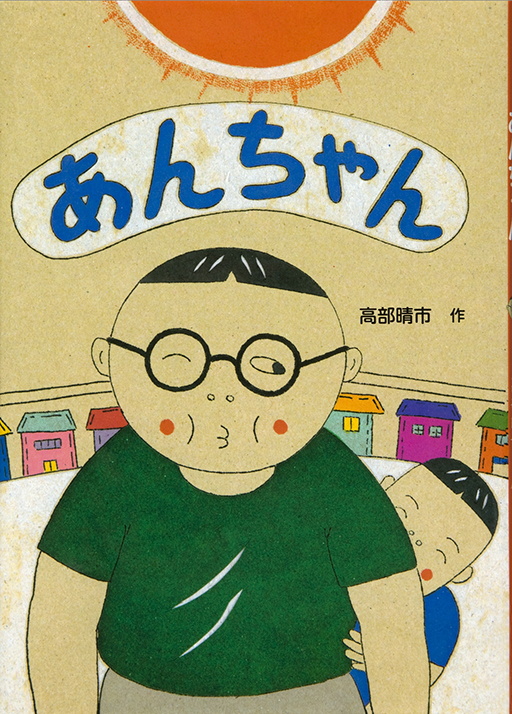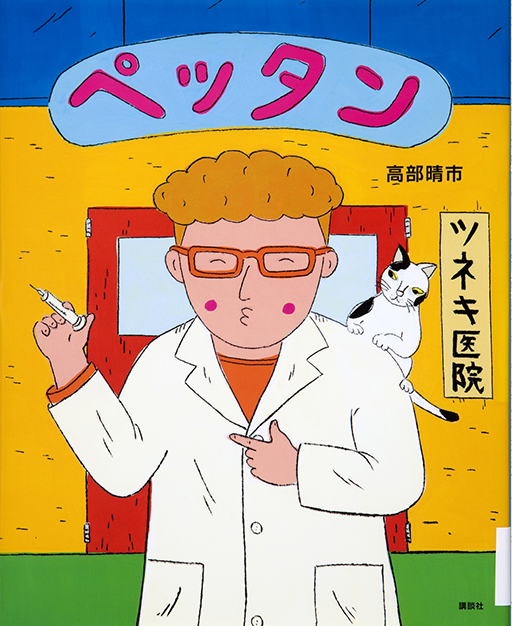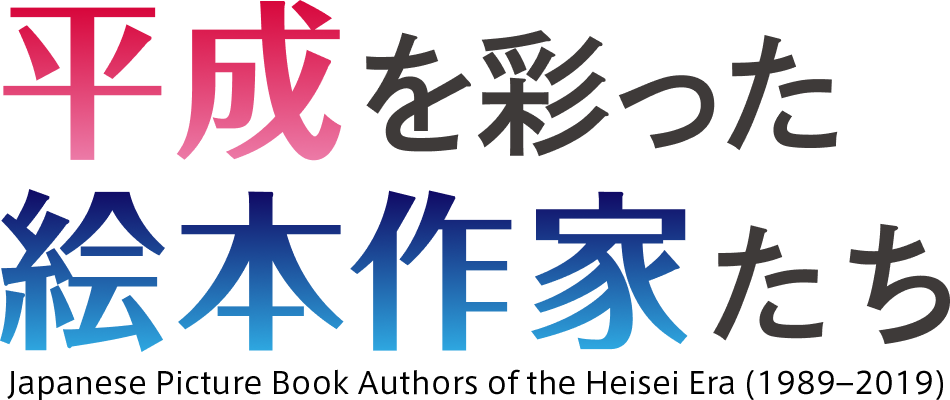Introduction of authors 3
19 Nakaya Miwa (1971-)
After working as a character designer at a company, she decided to become a picture book creator because she wanted to create something that would continue to be loved for generations, and studied in courses by the picture book creator Kawabata Makoto (1952-) and the editor Matsuda Motoko. Many of her works became series which vividly portray her adorable and unique characters, including the "Soramamekun [broad bean]" series which began with her debut work "Soramamekun no beddo [The bed of broad bean]" in 1997.
*"Kodomo no tomo Nenchu muki [Children's companion For ages 4-5]" May 1997 issue
-
![Exhibit Materials of Soramamekun no beddo [The bed of broad bean]](../../img/books/img_076.jpg)
76. Soramamekun no beddo [The bed of broad bean] Fukuinkan Shoten Publishers 1997 Y17-M99-1145 -
![Exhibit Materials of Kureyon no kurokun [Kuro-kun, the crayon]](../../img/books/img_077.jpg)
77. Kureyon no kurokun [Kuro-kun, the crayon] DOSHINSHA PUBLISHING 2001 Y17-N02-154 -
![Exhibit Materials of Yasai no gakko: Tomatochan no tabidachi [Vegetable school: Tomato-chan's trip]](../../img/books/img_078.jpg)
78. Yasai no gakko: Tomatochan no tabidachi [Vegetable school: Tomato-chan's trip] Hakusensha 2016 Y17-N16-L531 -
![Exhibit Materials of Dare kana? Dare kana? [Guess Who I am!]](../../img/books/img_079.jpg)
79. Dare kana? Dare kana? [Guess Who I am!] Fukuinkan Shoten Publishers 2000 Y17-N03-H245
20 Iwai Toshio (1962-)
While in college, he began creating computer driven video works, and garnered attention as a media artist both in Japan and overseas. He realized the virtues of paper and wood as materials when his daughter was born, and produced his first picture book "Docchi ga hen? [Which one is strange?]" based on a game he had invented to entertain his daughter. He has continued to product picture books filled with unique ideas since then, including the "100kaidate no ie [A house of 100 stories]" series which open vertically.
-
![Exhibit Materials of 100kaidate no ie [A house of 100 stories]](../../img/books/img_080.jpg)
80. 100kaidate no ie [A house of 100 stories] Kaiseisha 2008 Y17-N08-J666 -
![Exhibit Materials of Docchi ga hen? [Which one is strange?]](../../img/books/img_081.jpg)
81. Docchi ga hen? [Which one is strange?] Kinokuniya Company 2006 Y17-N06-H833 -
![Exhibit Materials of Yubisakichan no daiboken [Yubisaki-chan's big adventure]](../../img/books/img_082.jpg)
82. Yubisakichan no daiboken [Yubisaki-chan's big adventure] Hakusensha 2016 Y17-N16-L713 -
![Exhibit Materials of Boku, Dojio. [I'm Dojio]](../../img/books/img_083.jpg)
83. Boku, Dojio. [I'm Dojio] Shogakukan 2016 Y17-N16-L1166
21 Miura Taro (1968-)
After winning at the Bologna Illustrators Exhibition, he shifted from being an illustrator to being a picture book creator. His style of composing using simple shapes caught the attention of publishers overseas, and his debut work, "Je suis..." was published in Switzerland (in 2004). Later, his experiences raising children led him to create picture books filled with interesting ideas and ingenuity. His picture books for infants "Kuttsuita [Hello, love!]" and "Chiisana osama [The tiny king]", which incorporated collages*, were very well received and made in to series.
*A technique of composing 2 dimensional works by pasting together various materials, such as newspaper, cloth, etc., on a surface.
-
![Exhibit Materials of Boku wa… [I am…]](../../img/books/img_084.jpg)
84. Boku wa… [I am…] Bronze Publishing 2005 Y17-N05-H947 -
![Exhibit Materials of Kuttsuita [Hello, love!]](../../img/books/img_085.jpg)
85. Kuttsuita [Hello, love!] KOGUMA Publishing 2005 Y17-N06-H205 -
![Exhibit Materials of Oshiri [Bottoms]](../../img/books/img_086.jpg)
86. Oshiri [Bottoms] Kodansha 2008 Y17-N08-J606 -
![Exhibit Materials of Chiisana osama [The tiny king]](../../img/books/img_087.jpg)
87. Chiisana osama [The tiny king] Kaiseisha 2010 Y17-N10-J557
22 Kagakui Hiroshi (1955-2009)
He created picture books while working as a teacher at a special needs school, and made his debut as a picture book creator at the age of 50 in 2005. Based on his experience as an educator, he sought to produce picture books which elicit laughter and cheer readers up, and published 16 picture books until his sudden death in 2009. His works depict numerous Japanese motifs, including the daruma (Dharma doll) from "Darumasan ga [Mr. Daruma...]", rice cakes, futons, and more.
-
![Exhibit Materials of Darumasan ga [Mr. Daruma...]](../../img/books/img_088.jpg)
88. Darumasan ga [Mr. Daruma...] Bronze Publishing 2008 Y17-N08-J88 -
![Exhibit Materials of Omochi no kimochi [The rice cake's feelings]](../../img/books/img_089.jpg)
89. Omochi no kimochi [The rice cake's feelings] Kodansha 2005 Y17-N06-H108 -
![Exhibit Materials of Hakkiyoi hatake basho [Sumo vegetable garden]](../../img/books/img_090.jpg)
90. Hakkiyoi hatake basho [Sumo vegetable garden] Kodansha 2008 Y17-N08-J920 -
![Exhibit Materials of Ofuton kaketara [When you get under the blankets]](../../img/books/img_091.jpg)
91. Ofuton kaketara [When you get under the blankets] Bronze Publishing 2009 Y17-N09-J1235
23 Takabe Seiichi (1950-)
He has produced picture books with a wide range of different content, from nonsensical works such as "Kingyo no kaisuiyoku [The goldfish's sea bath]" to more humane works such as "Anchan [Big bro]". Many of his original drawings are printed on brown cardboard by mimeograph*, which gives them a unique warm and retro feel that was also very popular overseas. In addition to picture books, he is also active in the design and illustration fields.
* A simple printing technique which uses an iron pen to scrape away wax from wax-coated paper. In Japanese the word for the sound of the scraping is "garigari", which led to the common Japanese name of "gari ban" ("scratching board"). The proper name of the technique in Japanese is "toshaban" ("copy board").
-
![Exhibit Materials of Ofuro ni hairo [Enjoy taking a bath!]](../../img/books/img_092.jpg)
92. Ofuro ni hairo [Enjoy taking a bath!] Suzuki Publishing 1995 Y18-10835 -
![Exhibit Materials of Kingyo no kaisuiyoku [The goldfish's sea bath]](../../img/books/img_093.jpg)
93. Kingyo no kaisuiyoku [The goldfish's sea bath] Froebel-Kan 1999 Y17-M99-917 -

94. Anchan DOSHINSHA PUBLISHING 2013 Y17-N13-L273 -

95. Pettan Kodansha 2013 Y17-N13-L379
24 Tanaka Kiyo (1972-)
She studied oil painting and printmaking at art college, and began producing picture books while still in college. Based on her own experiences as a child, she creates picture books which come very close to a child's feelings, depicting her own childhood worries and the unique feelings and sensations of childhood. Her works are characterized by the powerful but delicate lines of her copper plate prints, use of warm colored paints, and a unique worldview based on motifs of plants and animals. She is also active in holding printmaking workshops, story reading events, and other activities.
-
![Exhibit Materials of Tomatosan [Miss Tomato]](../../img/books/img_096.jpg)
96. Tomatosan [Miss Tomato] Fukuinkan Shoten Publishers 2002 Y17-N06-H870 -
![Exhibit Materials of Okiniri [My favorite]](../../img/books/img_097.jpg)
97. Okiniri [My favorite] Hisakata Child 1998 Y17-M98-768 -
![Exhibit Materials of Obake ga kowai Kotokochan [Kotoko-chan is afraid of ghosts]](../../img/books/img_098.jpg)
98. Obake ga kowai Kotokochan [Kotoko-chan is afraid of ghosts] Billiken 2000 Y17-N00-407 -
![Exhibit Materials of Kuroino [The little one]](../../img/books/img_099.jpg)
99. Kuroino [The little one] Kaiseisha 2018 Y17-N18-L1141
25 Ito Hideo (1950-)
He has been presenting his art at private exhibitions and shows while teaching painting classes for children since the 1970s. He became involved in the production of picture books after showing some of his past work to an editor at a picture book publishing company. He likes to use dark reds and blues, and his works are characterized by intense colors and strong brush strokes. He has produced many picture books depicting intrinsically Japanese scenes such as small festivals and traditional events.
-
![Exhibit Materials of Umi no natsu [Umi's Summer]](../../img/books/img_100.jpg)
100. Umi no natsu [Umi's Summer] Holp Shuppan 1991 Y18-6562 -
![Exhibit Materials of Himitsu no natsumatsuri: Kodomo zairen [Secret summer festival: Children Zairen]](../../img/books/img_101.jpg)
101. Himitsu no natsumatsuri: Kodomo zairen [Secret summer festival: Children Zairen] DOSHINSHA PUBLISHING 1989 Y18-4431 -
![Exhibit Materials of Tochan nanka beda! [Nya nya, dad!]](../../img/books/img_102.jpg)
102. Tochan nanka beda! [Nya nya, dad!] POPLAR Publishing 2008 Y17-N08-J1107 -
![Exhibit Materials of Ushio [Ushio]](../../img/books/img_103.jpg)
103. Ushio [Ushio] Billiken 2007 Y17-N08-J590
26 Nishimura Toshio (1964-)
While working as an interior designer, he was introduced to the appeal of picture books when his son was born, and became interested in picture book creators. Just before turning 40 in 2003, he took his picture book "Barubarusan [Mr. Barbar the barber]" (written by Inui Eriko) to a publishing company and it was selected for "Kodomo no tomo Nenchu muki [Children's companion for ages 4-5]", which led him to begin his career in picture books. Since then, he has aimed to create picture books which are not influenced by fleeting trends and will continue to be loved for a long time. His works feature characters who seem relaxed and at ease and are comfortable and relaxing to look at, painted in a heavy style in multiple layers using acrylic paint.
-
![Exhibit Materials of Mori no ofuro [Animals' bath in the woods]](../../img/books/img_104.jpg)
104. Mori no ofuro [Animals' bath in the woods] Fukuinkan Shoten Publishers 2004 Y17-N08-J358 -
![Exhibit Materials of Dobutsu sakasu hajimaruyo [Welcome to the animal circus]](../../img/books/img_105.jpg)
105. Dobutsu sakasu hajimaruyo [Welcome to the animal circus] Fukuinkan Shoten Publishers 2006 Y17-N09-J1180 -
![Exhibit Materials of Kumakumapan [Bear, bear, bread]](../../img/books/img_106.jpg)
106. Kumakumapan [Bear, bear, bread] Akane Shobo 2013 Y17-N13-L969 -
![Exhibit Materials of Bububu doko itta [Bu, bu, bu, where did you go?]](../../img/books/img_107.jpg)
107. Bububu doko itta [Bu, bu, bu, where did you go?] Gakken Education Publishing 2012 Y17-N12-J1035
27 Hasegawa Yoshifumi (1961-)
He has created serious picture books with strong messages, such as "Boku ga ramen tabeteru toki [While I was eating ramen...]" which makes the reader think about peace, while also publishing many humorous picture books such as "Dajare Nippon isshu [Punny trip around Japan]". In addition, he does not work only on picture books, but is also actively involved in translating works from overseas, and holding lively story reading events which involve reading picture books with music and improvised performances.
-
![Exhibit Materials of Boku ga ramen tabeteru toki [While I was eating ramen...]](../../img/books/img_108.jpg)
108. Boku ga ramen tabeteru toki [While I was eating ramen...] Kyouikugageki 2007 Y17-N07-H1081 -
![Exhibit Materials of Tengoku no otochan [My father in heaven]](../../img/books/img_109.jpg)
109. Tengoku no otochan [My father in heaven] Kodansha 2008 Y17-N09-J85 -
![Exhibit Materials of Oheso no ana [Belly button hole]](../../img/books/img_110.jpg)
110. Oheso no ana [Belly button hole] BL Shuppan 2006 Y17-N07-H447 -
![Exhibit Materials of Iikara iikara [It's okay, it's okay]](../../img/books/img_111.jpg)
111. Iikara iikara [It's okay, it's okay] Ehonkan Publishers 2006 Y17-N07-H548 -
![Exhibit Materials of Dajare Nippon isshu [Punny trip around Japan]](../../img/books/img_112.jpg)
112. Dajare Nippon isshu [Punny trip around Japan] Rironsha 2009 Y17-N10-J112 -
![Exhibit Materials of Mawaru osushi [Revolving sushi]](../../img/books/img_113.jpg)
113. Mawaru osushi [Revolving sushi] Bronze Publishing 2012 Y17-N12-J308
Lowered age of readers
After World War II, greater focus was placed on education for young children, and the number of children who began reading picture books expanded to not only preschool children, but also to children under the age of 3 years old. In 1964, the "Kodomo ga hajimete deau ehon [Children's first picture book] series" began to be published. There was an increase in the number of picture books which were aimed at young children and presented the colors, shapes, and names of items, or contained simple pictures and simple stories. Thereafter, in 1995, the "monthly picture book magazine Kodomo no tomo 0.1.2. [Children's companion 0.1.2.]", aimed at 0, 1, and 2 year olds, began to be published. The publication of picture books for toddlers has increased even more since 2000 onward.
When picture books aimed at toddlers first began to appear, there was some skepticism regarding giving picture books to these very young children, saying that parents and guardians should instead be interacting with these children directly and not through picture books. However, as research progressed on children's growth and development, and parent-child relationships, more and more picture books appeared which effectively utilized onomatopoeic and mimetic words, included innovative surprises when turning pages, and promoted fingerplay and body movement, and came to be widely used in toddler education and childcare settings.
The editors who support the picture book creators 2
Matsuda Motoko (1955-)
At Kaiseisha, she was involved in the creation of the monthly magazine "MOE"*, which specialized in picture book information, and later served as editor in chief. After going freelance in 1989, she focused on discovering and developing new creators through workshops and other means, and was involved in the debuts of Nakaya Miwa, Hasegawa Yoshifumi, and others. From the 3rd book in the series she edited the "Miyazawa Kenji Picture Book" series, which attracted much attention even among other picture book creators, building a strong presence as an editor, and has also worked on translations of foreign works.
* Originally published by Kaiseisha as monthly magazine "Ehon to ohanashi [Picture books and stories]" and later renamed. Currently published by Hakusensha.
